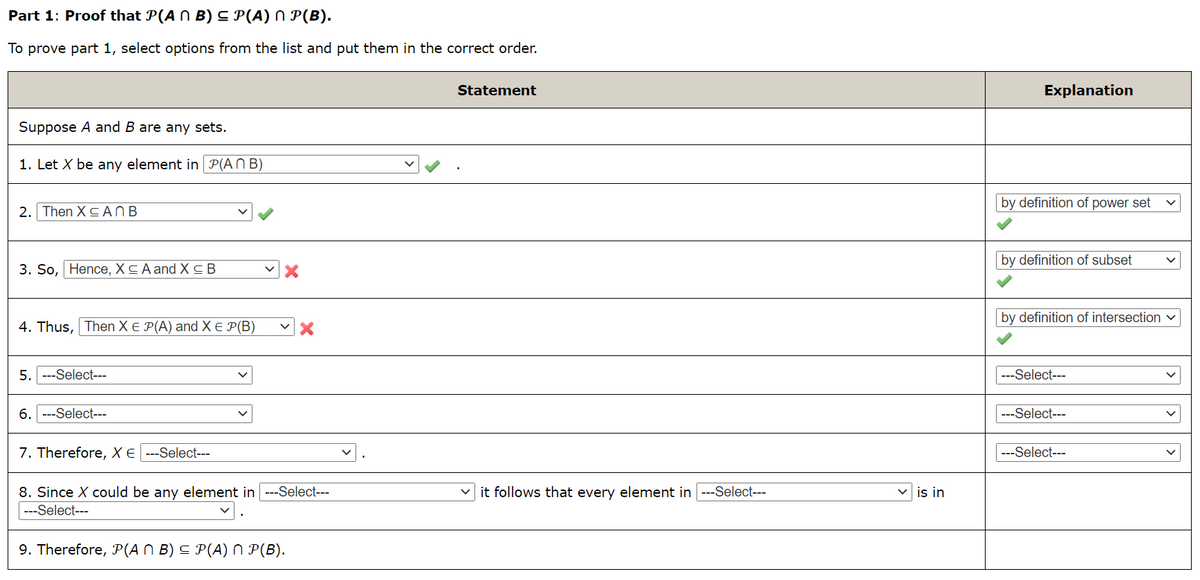Part 1: Proof that P(A N B) S P(A) N P(B). To prove part 1, select options from the list and put them in the correct order. Statement Explanation Suppose A and B are any sets. 1. Let X be any element in P(ĀN B) by definition of power set 2. Then XC ANB by definition of subset 3. So, Hence, XC A and X c B by definition of intersection ♥ 4. Thus, Then X € P(A) and X e P(B) 5. ---Select--- ---Select--- 6. ---Select--.. ---Select--- 7. Therefore, X e ---Select-- ---Select--- 8. Since X could be any element in ---Select--- ---Select--- v it follows that every element in --Select--- is in v. 9. Therefore, P(A N B) C P(A) N P(B).
Part 1: Proof that P(A N B) S P(A) N P(B). To prove part 1, select options from the list and put them in the correct order. Statement Explanation Suppose A and B are any sets. 1. Let X be any element in P(ĀN B) by definition of power set 2. Then XC ANB by definition of subset 3. So, Hence, XC A and X c B by definition of intersection ♥ 4. Thus, Then X € P(A) and X e P(B) 5. ---Select--- ---Select--- 6. ---Select--.. ---Select--- 7. Therefore, X e ---Select-- ---Select--- 8. Since X could be any element in ---Select--- ---Select--- v it follows that every element in --Select--- is in v. 9. Therefore, P(A N B) C P(A) N P(B).
College Algebra
7th Edition
ISBN:9781305115545
Author:James Stewart, Lothar Redlin, Saleem Watson
Publisher:James Stewart, Lothar Redlin, Saleem Watson
Chapter9: Counting And Probability
Section: Chapter Questions
Problem 3CC: (a) What is a combination of r elements of a set? How many combinations are there of n elements...
Related questions
Question
Can you fill in the blanks for me? What is the correct answer?

Transcribed Image Text:Part 1: Proof that P(A N B) C P(A) N P(B).
To prove part 1, select options from the list and put them in the correct order.
Statement
Explanation
Suppose A and B are any sets.
1. Let X be any element in P(ANB)
by definition of power set
2. Then X ANB
by definition of subset
3. So, Hencе, Xс А and X С В
by definition of intersection v
4. Thus, Then X E P(A) and X E P(B)
5. ---Select---
---Select---
6. ---Select---
---Select---
7. Therefore, XE ---Select---
---Select---
8. Since X could be any element in ---Select---
it follows that every element in
--Select---
is in
---Select--
9. Therefore, P(A N B) C P(A) N P(B).
Expert Solution
This question has been solved!
Explore an expertly crafted, step-by-step solution for a thorough understanding of key concepts.
This is a popular solution!
Trending now
This is a popular solution!
Step by step
Solved in 2 steps

Knowledge Booster
Learn more about
Need a deep-dive on the concept behind this application? Look no further. Learn more about this topic, probability and related others by exploring similar questions and additional content below.Recommended textbooks for you

College Algebra
Algebra
ISBN:
9781305115545
Author:
James Stewart, Lothar Redlin, Saleem Watson
Publisher:
Cengage Learning

Algebra and Trigonometry (MindTap Course List)
Algebra
ISBN:
9781305071742
Author:
James Stewart, Lothar Redlin, Saleem Watson
Publisher:
Cengage Learning

College Algebra
Algebra
ISBN:
9781305115545
Author:
James Stewart, Lothar Redlin, Saleem Watson
Publisher:
Cengage Learning

Algebra and Trigonometry (MindTap Course List)
Algebra
ISBN:
9781305071742
Author:
James Stewart, Lothar Redlin, Saleem Watson
Publisher:
Cengage Learning